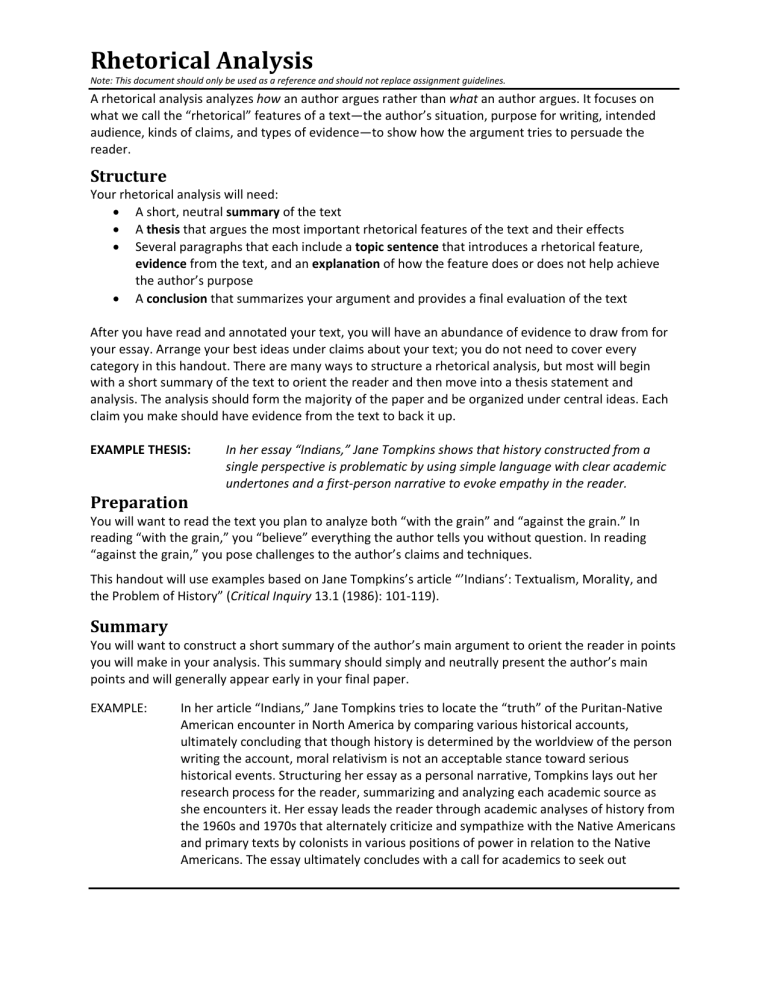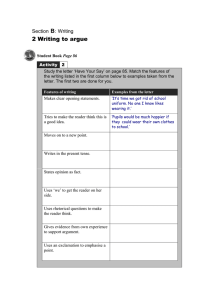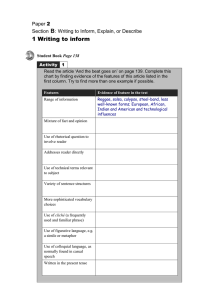
Rhetorical Analysis Note: This document should only be used as a reference and should not replace assignment guidelines. A rhetorical analysis analyzes how an author argues rather than what an author argues. It focuses on what we call the “rhetorical” features of a text—the author’s situation, purpose for writing, intended audience, kinds of claims, and types of evidence—to show how the argument tries to persuade the reader. Structure Your rhetorical analysis will need: • A short, neutral summary of the text • A thesis that argues the most important rhetorical features of the text and their effects • Several paragraphs that each include a topic sentence that introduces a rhetorical feature, evidence from the text, and an explanation of how the feature does or does not help achieve the author’s purpose • A conclusion that summarizes your argument and provides a final evaluation of the text After you have read and annotated your text, you will have an abundance of evidence to draw from for your essay. Arrange your best ideas under claims about your text; you do not need to cover every category in this handout. There are many ways to structure a rhetorical analysis, but most will begin with a short summary of the text to orient the reader and then move into a thesis statement and analysis. The analysis should form the majority of the paper and be organized under central ideas. Each claim you make should have evidence from the text to back it up. EXAMPLE THESIS: Preparation In her essay “Indians,” Jane Tompkins shows that history constructed from a single perspective is problematic by using simple language with clear academic undertones and a first-person narrative to evoke empathy in the reader. You will want to read the text you plan to analyze both “with the grain” and “against the grain.” In reading “with the grain,” you “believe” everything the author tells you without question. In reading “against the grain,” you pose challenges to the author’s claims and techniques. This handout will use examples based on Jane Tompkins’s article “’Indians’: Textualism, Morality, and the Problem of History” (Critical Inquiry 13.1 (1986): 101-119). Summary You will want to construct a short summary of the author’s main argument to orient the reader in points you will make in your analysis. This summary should simply and neutrally present the author’s main points and will generally appear early in your final paper. EXAMPLE: In her article “Indians,” Jane Tompkins tries to locate the “truth” of the Puritan-Native American encounter in North America by comparing various historical accounts, ultimately concluding that though history is determined by the worldview of the person writing the account, moral relativism is not an acceptable stance toward serious historical events. Structuring her essay as a personal narrative, Tompkins lays out her research process for the reader, summarizing and analyzing each academic source as she encounters it. Her essay leads the reader through academic analyses of history from the 1960s and 1970s that alternately criticize and sympathize with the Native Americans and primary texts by colonists in various positions of power in relation to the Native Americans. The essay ultimately concludes with a call for academics to seek out FL 208 • 801-863-8936 • www.uvu.edu/writingcenter Facebook: UVUWritingCenter • Twitter: @uvuwritingctr Rhetorical Analysis Note: This document should only be used as a reference and should not replace assignment guidelines. Analysis competing accounts of history and to piece together a story of what happened “according to what seems reasonable and plausible” (118). Purpose and audience should underlie everything the author writes. Think about how the audience would react to what you’re reading. Take special note of the rhetorical features below: Purpose or Rhetorical Situation What is motivating the author to write this piece? Does the author want to • express a certain idea or opinion? • respond to a particular occasion or another text? • explore a topic or inquire into a problem? • inform the reader about a topic that is misunderstood? • analyze, synthesize, and interpret data? • persuade the reader of an argument? • reflect on a topic? • advocate for change? EXAMPLE: Audience Tompkins has multiple purposes in writing this piece: she is responding to the problem of finding the “truth” in historical accounts, informing the reader about how history is constructed, reflecting on the problems of escaping a single perspective, and trying to persuade the reader to be more skeptical in the research process. To whom is the author writing? Reading the text through the intended audience’s point of view is essential because rhetorical decisions change depending on the audience. EXAMPLE: Tompkins is writing to an academic audience familiar with the process of historical research, though her simplified language and use of first-person experience make the essay accessible to a broader audience that might include undergraduate students and the educated general reader. The author is reflecting on the process of how historical knowledge is formed and wants the audience to think about what might seem to be a straightforward process in a new way. Angle of vision How does the author control what the reader sees? In other words, where does the author use words with certain connotations or create a certain tone or style? How does the author reveal her point of view? EXAMPLES: Tompkins attempts to make her research process look objective: she shows the reader how she systematically consults a wide range of historical accounts, from primary sources written by colonists to analyses by historians trained in differing schools of thought. Ultimately, however, the reader can only see her research process through Tompkins’s own perspective—which is the point she implicitly arrives at in the end of her essay. The unusual use of first-person in this academic article highlights this insight. For instance, when she writes, “I did not care to have any real exemplars interfering with what I already knew” (101), she draws attention to the fact that her personal feelings influenced how she approached her research. Utah Valley University (UVU) does not discriminate on the basis of race, color, religion, national origin, sex, sexual orientation, gender identity, age (40 and over), disability status, veteran status, pregnancy, childbirth, or pregnancy-related conditions, citizenship, genetic information, or other bases protected by applicable law in employment, treatment, admission, access to educational programs and activities, or other University benefits or services. Rhetorical Analysis Note: This document should only be used as a reference and should not replace assignment guidelines. Tompkins cannot completely escape her academic persona, however. Her use of terms like “antifoundationalist epistemology” (103) shows her academic training and works against her attempts to be accessible to the general reader. Concessions and Refutations Does the author include evidence that does not support her claims? If so, how does the author respond to it and what does this suggest about her rhetorical position? • Concessions acknowledge that another perspective has some merit. • Refutations show the problems in another point of view and argue for the author’s position. EXAMPLE: Tompkins concedes that relativism is an appealing and sometimes useful tactic when dealing with historical accounts that seem irreconcilable, but she ultimately concludes that some historical situations—like those involving genocide or extreme brutality— demand more definitive moral judgment. Classical Rhetorical Appeals Generally, academic writing relies mainly on ethos and logos, while more popular writing may include appeals to all three or may rely on one more than the others. Why might this be the case for your article? • Ethos refers to an author’s creation of a credible persona. How does the author establish credibility or authority? EXAMPLE: • Logos refers to appeals to logic. How does the author establish the logic of his argument? EXAMPLE: • Tomkins systematically lays out her research process in narrative form, showing the reader how many different sources she consulted in writing the article, establishing her professional credibility. The logos of Tompkins’s argument is established in a similar way to her ethos: her systematic explanation of her research process creates a logical sequence for the reader to follow. Pathos refers to appeals to emotion. Where does the author try to emotionally engage the reader in the argument? EXAMPLE: Unusually for an academic essay, Tompkins begins with a personal account of her childhood impressions of “Indians” and continues to narrate the rest of the essay in first person. This narration establishes a more personal bond with the reader than most other academic writing, which generally avoids personal anecdotes. The information in this handout is based on Allyn and Bacon Guide to Writing (Ed. John Ramage, John Bean, and June Johnson, Brief 5th ed., 2009, pp. 16-56), and From Inquiry to Academic Writing (Stuart Greene and April Lidinsky, 2008, pp. 47-64). Utah Valley University (UVU) does not discriminate on the basis of race, color, religion, national origin, sex, sexual orientation, gender identity, age (40 and over), disability status, veteran status, pregnancy, childbirth, or pregnancy-related conditions, citizenship, genetic information, or other bases protected by applicable law in employment, treatment, admission, access to educational programs and activities, or other University benefits or services. FL 208 • 801-863-8936 • www.uvu.edu/writingcenter Facebook: UVUWritingCenter • Twitter: @uvuwritingctr


